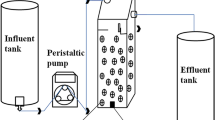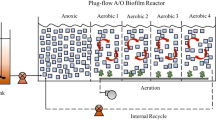Abstract
The immobilization of microorganisms is essential for efficient bioaugmentation systems. The performance of Bacillus cereus G5 as biofilm-forming bacteria and Comamonas testosteroni A3 a 3,5 dinitrobenzoic acid (DNB)-degrading strain] in laboratory-scale sequencing batch biofilm reactors (SBBRs) treating DNB synthetic wastewater has been examined. The microbial diversity in the reactors was also explored. The reactor R3 inoculated with B. cereus G5 and C. testosteroni A3 together not only improved the removal of contaminants, but also exhibited obvious resistance to shock loading with DNB during later operations. Pyrosequencing was used to evaluate bacterial communities in three reactors. Comamonas was predominant in the reactor R3, indicating the effect of G5 in promoting immobilization of A3 cells in biofilms. Those microbial resources, e.g.G5, which can stimulate the self-immobilization of the degrading bacteria offer a novel strategy for immobilization of degraders in bioaugmentation systems and show broader application prospects.





Similar content being viewed by others
References
Abe A, Furukawa S, Watanabe S, Morinaga Y (2013) Yeasts and lactic acid bacteria mixed-specie biofilm formation is a promising cell immobilization technology for ethanol fermentation. Appl Biochem Biotechnol 171:72–79
Boon N, Top EM, Verstraete W, Siciliano SD (2003) Bioaugmentation as a tool to protect the structure and function of an activated-sludge microbial community against a 3-chloroaniline shock load. Appl Environ Microbiol 69:1511–1520
Buswell CM, Herlihy YM, Marsh PD, Keevil CW, Leach SA (1997) Coaggregation amongst aquatic biofilm bacteria. J Appl Microbiol 83:477–484
Cheng ZQ, Meng XX, Wang HC, Chen M, Li MY (2014) Isolation and characterization of broad spectrum coaggregating bacteria from different water systems for potential use in bioaugmentation. PLoS ONE 9:e94220
Diana DG, Fambrini L, Coppini E, Fava F, Barberio C (2004) Aggregation-based cooperation during bacterial aerobic degradation of polyethoxylated nonylphenols. Res Microbiol 155:761–769
Duque AF, Bessa VS, Carvalho MF, Castro PM (2011) Bioaugmentation of a rotating biological contactor for degradation of 2-fluorophenol. Bioresour Technol 102:9300–9303
Kolenbrander PE (2000) Oral microbial communities: biofilms, interactions, and genetic systems. Annu Rev Microbiol 54:413–437
Lawniczak L, Kaczorek E, Olszanowski A (2011) The influence of cell immobilization by biofilm forming on the biodegradation capabilities of bacterial consortia. World J Microbiol Biotechnol 27:1183–1188
Li MY, Peng L, Ji Z, Xu JL, Li SP (2008) Establishment and characterization of dual-species biofilms formed from a 3,5-dinitrobenzoic-degrading strain and bacteria with high biofilm-forming capabilities. FEMS Microbiol Lett 278:15–21
Li CY, Li Y, Cheng XS, Feng LP, Xi CW, Zhang Y (2013) Immobilization of Rhodococcus rhodochrous BX2 (an acetonitrile-degrading bacterium) with biofilm-forming bacteria for wastewater treatment. Bioresour Technol 131:390–396
Limbergen VH, Top EM, Verstraete W (1998) Bioaugmentation in activated sludge: current features and future perspectives. Appl Microbiol Biotechnol 50:16–23
Mah TC, O’Toole GA (2001) Mechanisms of biofilm resistance to antimicrobial agents. Trends Microbiol 9:34–39
Malik A, Sakamoto M, Hanazaki S, Osawa M, Suzuki T, Tochigi M, Kakii K (2003a) Coaggregation among nonflocculating bacteria isolated from activated sludge. Appl Environ Microbiol 69:6056–6063
Malik A, Sakamoto M, Ono T, Kakii K (2003b) Coaggregation between Acinetobacter johnsonii S35 and Microbacterium esteraromaticum strains isolated from sewage activated sludge. J Biosci Bioeng 96:10–15
Park JY, Choi YJ, Moon S, Shin DY, Nam K (2009) Microbubble suspension as a carrier of oxygen and acclimated bacteria for phenanthrene biodegradation. J Hazard Mater 163:761–767
Rickard AH, Gilbert P, Handley PS (2004) Influence of growth environment on coaggregation between freshwater biofilm bacteria. J Appl Microbiol 96:1367–1373
Simoes LC, Simoes M, Vieira MJ (2008) Intergeneric coaggregation among drinking water bacteria: evidence of a role for Acinetobacter calcoaceticus as a bridging bacterium. Appl Environ Microbiol 74:1259–1263
Zhu J, Mekalanos JJ (2003) Quorum sensing-dependent biofilms enhance colonization in Vibrid cholerae. Dev Cell 5:647–656
Acknowledgments
This work was supported by the National Natural Science Foundation of China (no. 51079094) and Suzhou Environment Protection Agency (no.C201302).
Author information
Authors and Affiliations
Corresponding author
Additional information
Zhongqin Cheng and Mei Chen have contributed equally to this paper.
Rights and permissions
About this article
Cite this article
Cheng, Z., Chen, M., Xie, L. et al. Bioaugmentation of a sequencing batch biofilm reactor with Comamonas testosteroni and Bacillus cereus and their impact on reactor bacterial communities. Biotechnol Lett 37, 367–373 (2015). https://doi.org/10.1007/s10529-014-1684-1
Received:
Accepted:
Published:
Issue Date:
DOI: https://doi.org/10.1007/s10529-014-1684-1




